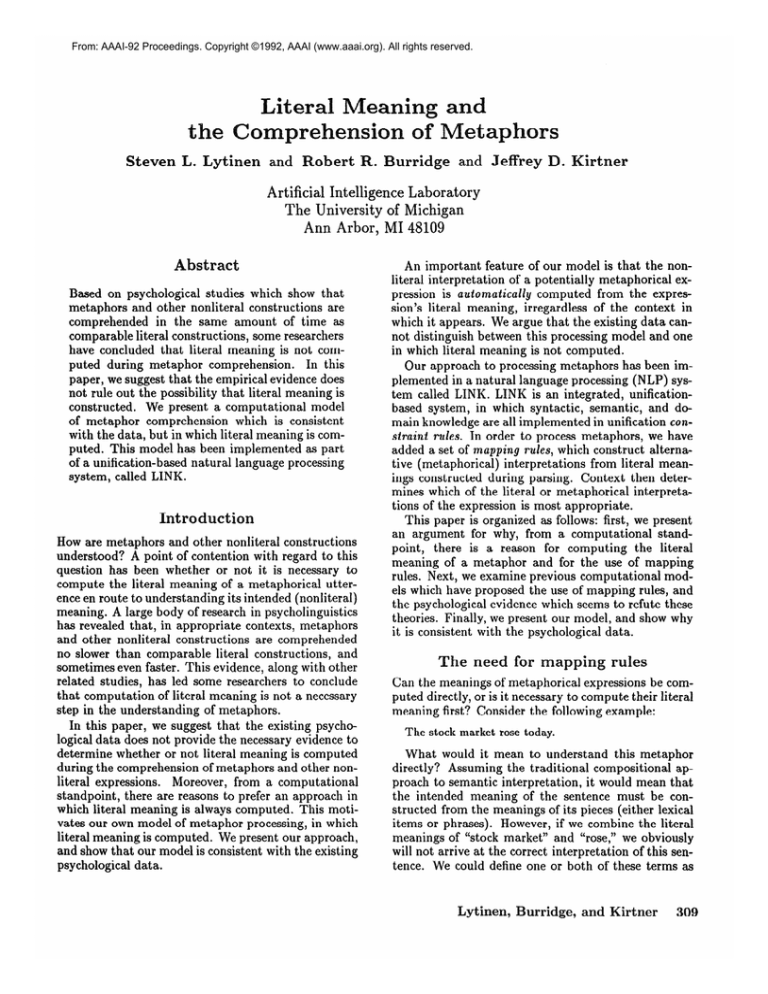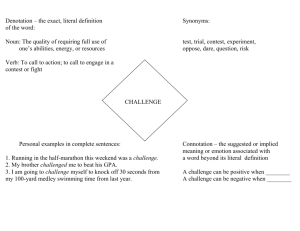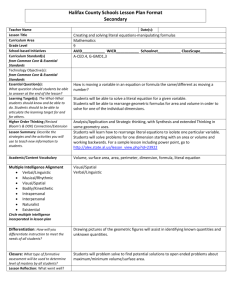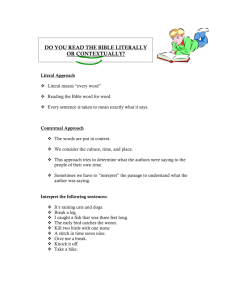
From: AAAI-92 Proceedings. Copyright ©1992, AAAI (www.aaai.org). All rights reserved.
Literal Meaning
re
Steven L. Lytinen
and Robert
and
R. Burridge
and Jeffrey D. Kirtner
Artificial Intelligence Laboratory
The University of Michigan
Ann Arbor, MI 48109
Abstract
Based on psychological studies which show that
metaphors and other nonliteral constructions are
comprehended in the same amount of time as
comparable literal constructions, some researchers
have concluded that literal meaning is not computed during metaphor comprehension.
In this
paper, we suggest that the empirical evidence does
not rule out the possibility that literal meaning is
constructed. We present a computational model
of metaphor comprehension which is consistent
with the data, but in which literal meaning is computed. This model has been implemented as part
of a unification-based natural language processing
system, called LINK.
Introduction
How are metaphors and other nonliteral constructions
understood? A point of contention with regard to this
question has been whether or not it is necessary to
compute the literal meaning of a metaphorical utterence en route to understanding its intended (nonliteral)
meaning. A large body of research in psycholinguistics
has revealed that, in appropriate contexts, metaphors
and other nonliteral constructions are comprehended
no slower than comparable literal constructions, and
sometimes even faster. This evidence, along with other
related studies, has led some researchers to conclude
that computation of literal meaning is not a necessary
step in the understanding of metaphors.
In this paper, we suggest that the existing psychological data does not provide the necessary evidence to
determine whether or not literal meaning is computed
during the comprehension of metaphors and other nonliteral expressions. Moreover, from a computational
standpoint, there are reasons to prefer an approach in
which literal meaning is always computed. This motivates our own model of metaphor processing, in which
literal meaning is computed. We present our approach,
and show that our model is consistent with the existing
psychological data.
An important feature of our model is that the nonliteral interpretation of a potentially metaphorical expression is &omaiicalZy computed from the expression’s literal meaning, irregardless of the context in
which it appears. We argue that the existing data cannot distinguish between this processing model and one
in which literal meaning is not computed.
Our approach to processing metaphors has been implemented in a natural language processing (NLP) system called LINK. LINK is an integrated, unificationbased system, in which syntactic, semantic, and domain knowledge are all implemented in unification constraint rules. In order to process metaphors, we have
added a set of mapping rules, which construct alternative (metaphorical) interpretations from literal meanings constructed during parsing. Context then determines which of the literal or metaphorical interpretations of the expression is most appropriate.
This paper is organized as follows: first, we present
an argument for why, from a computational standpoint, there is a reason for computing the literal
meaning of a metaphor and for the use of mapping
rules. Next, we examine previous computational models which have proposed the use of mapping rules, and
the psychological evidence which seems to refute these
theories. Finally, we present our model, and show why
it is consistent with the psychological data.
The need for mapping
rules
Can the meanings of metaphorical expressions be computed directty, or is it necessary to compute their literal
meaning first? Consider the following example:
The stock market rose today.
What would it mean to understand this metaphor
directly? Assuming the traditional compositional approach to semantic interpretation, it would mean that
the intended meaning of the sentence must be constructed from the meanings of its pieces (either lexical
items or phrases). However, if we combine the literal
meanings of “stock market” and “rose,” we obviously
will not arrive at the correct interpretation of this sentence. We could define one or both of these terms as
Lytinen, Burridge, and Kirtner
309
ambiguous, with “literal” and “metaphorical” senses,
but it is not clear that we can easily separate the meaning of the metaphor into components to be associated
with individual lexical items or phrases, as the compositional approach requires. For example, “rose” could
be defined ambiguously, as either referring to an increase in altitude or an increase in a numeric indicator, but this does not capture the generalization that
almost any word which refers to a change in altitude
can be used in the same way. Consider the following
examples:
The stock market plummeted today.
My fever has gone up.
Computer science enrollments are leveling off.
The 10% jump in property taxes this year was outrageous.
If we defined “rose” as ambiguous, we would also
have to define every other word which refers to a
change in altitude as ambiguous, in order to account
for the productivity of this metaphor, not a plausible
soluti0n.l
Metaphors such as the above example, which are tied
to general concepts rather than specific lexical items,
are not uncommon. We will not attempt to argue this
point here, as many others have presented convincing arguments as to the prevalence of highly productive metaphors and other nonliteral constructions (e.g.,
Lakoff and Johnson, 1980; Langacker, 1987). Given
their prevalence, it is important that we properly account for them, with a mechanism which explains their
productivity.
How can we write appropriately general interpretation rules for these kinds of metaphors? Since they are
often syntactically and lexically flexible, it seems that
the only way to do so is at the semantic level. Instances
of a given metaphor share commonalities in “literal”
meaning (e.g., all lexical items that can be used in the
“rose” metaphor normally refer to a change in altitude) and also in “intended” meaning (e.g., when used
metaphorically, words like “rose” refer to a change in
value of a numerical indicator). Thus, it seems natural to write an interpretation rule that transforms the
literal meaning of a construction to an alternate nonliteral one.
We will refer to this kind of rule as a mapping rule.
In the case of the “rose” metaphor, the mapping is from
a change in altitude to a change in value of a numerical
indicator. The direction of the change in value is “the
same” as the direction of the change in altitude: that
is, increase in altitude means increase in the numerical
indicator.
’Presumably, words that are commonly used in a particular metaphor (such as “rose”) do develop their own
“metaphorical” senses, thereby enabling direct comprehension of these alternate senses. However, given the productivity of many metaphors, it seems implausible that distinct
senses would develop for all lexical items that can be used
in a metaphor.
310
Natural Language: Interpretation
How can mapping rules be used in semantic interpretation? Comprehension of a nonliteral construction
using a mapping rule would involve constructing the
literal interpretation of the construction, identifying
the appropriate mapping rule, and applying the rule
to the literal interpretation, thereby yielding the intended (nonliteral) interpretation.
The Standard
ragmatie
Model
Many previous theories of metaphor comprehension
have proposed the use of mapping rules to account for
metaphor comprehension (e.g., Induryka, 1987; Carbonell, 1982; Searle, 1978). In fact, this approach has
been called the Standard Pragmatic Model (Gerrig,
1989). Gerrig outlined three general steps in the Standard Model:
1.
Construct the literal meaning of the utterance
2.
Identify a failed semantic or pragmatic constraint in the
literal meaning
3.
APPLY
a mapping rule to transform the literal meaning
to the intended meaning.
This model makes two predictions about processing. First, since steps 2 and 3 must be performed after
completion of step 1, it predicts that comprehension of
metaphors is slower than comprehension of comparable
literal utterances. Second, since step 3 above is only
executed if “normal” semantic and pragmatic processing fails to interpret an utterance, it predicts that the
metaphorical interpretation of an utterance is not computed in a context in which the literal interpretation
is acceptable.
Numerous psychological studies contradict both of
these predictions.
First, many studies have shown
that, in an appropriate context, metaphor comprehension is as fast as comprehension of comparable literal
expressions. In (Ortony et al., 1978) subjects read one
or more sentences which set up a context, then read
the target sentence, and then indicated as quickly as
possible that they understood the target by pressing a
key. There were two variations on this basic design. In
experiment 1, the context was either short or long. In
the short context, subjects took longer to understand
nonliteral than literal targets, but in long contexts the
reading times were not significantly different. In experiment 2, the targets were phrases that could have
either a literal or idiomatic interpretation, depending
on context. It was found that targets with an idiomatic
interpretation took no longer to process (and may be
processed faster) than the literal interpretations of the
same targets.
Gibbs (1979) reported similar contextual effects on
the comprehension of indirect requests. Subjects read
stories, one line at a time, which ended in either an
indirect request (e.g., “Must you open the window?“)
or a direct request (e.g., “Please open the window”).
In an appropriate context (i.e., a story in which the
context set up the expectation for a request), indirect
requests took no longer to comprehend than the direct
requests.
More recent experiments have on the whole confirmed that metphors take no longer to process than
literal statements in appropriate contexts. See Gerrig
(1989) or Gibbs (1984) for a more extensive discussion
of the evidence.
Gibbs has also examined the question of whether
or not literal meanings of indirect requests are activated during comprehension. In (Gibbs, 1983), he
found no evidence for activation of literal meaning if
an indirect request was comprehended in an appropriate context. Immediately after reading an indirect
request such as “Can you pass the salt?” subjects were
asked to make sentence/nonsentence judgments on target sentences. When the target was a paraphrase of
the literal meaning of the indirect request (e.g., a target about ability to pass the salt), there was no facilitation of this judgment task from the indirect request preceding it. However, in the reverse situation,
facilitation did occur: subjects were faster at making
sentence/nonsentence judgments on paraphrases of the
indirect request meaning even if the request was meant
literally. Gibbs concluded from this assymetry of priming that literal meaning of indirect requests was not
computed, but that the nonliteral meaning always was.
Clucksberg, Gildea, & Bookin (1982) addressed the
question of when literal and nonliteral meanings or
metaphors are computed. Subjects were asked to make
judgments about the literal truth of sentences of the
form “All/Some X are Y.” Subjects took significantly
longer to judge the truth of sentences which had a reasonable metaphorical meaning than those which did
not. That is, judgment about the literal truth of sentences such as “All men are wolves” was slower than
for “All men are telephones.” Since the task only required subjects to make judgements based on literal
meaning, the results suggest that metaphor comprehension is an automatic process; i.e., metaphorical interpretations are computed even when literal meaning
is intended.
The evidence against the Standard Model has led
some to conclude that literal meaning is not computed
during comprehension of nonliteral constructions. Perhaps the strongest proponent of this view is Gibbs,
who goes so far as to question the validity of the notion of literal meaning (Gibbs, 1984). However, as we
will argue in the next section, it is not the construction of literal meaning and the use of mapping rules
that causes the Standard Model to make these incorrect predictions, it is the way in which mapping rules
are applied in the model.
Metaphor
Processing
in LINK
We now present our alternative theory of metaphor
processing, which is implemented in the LINK system. While our model also utilizes mapping rules,
it differs from the Standard Pragmatic Model in that
the rules are applied automatically, rather than in a
failure-driven manner. As we will see later, automatic
application of mapping rules leads to correct predictions about reading times and activations.
In LINK, metaphor processing follows these general
steps:
Incrementally construct the (literal)
constituents of the utterance.
interpretation
of
As they are constructed, try to match the interpretations
against mapping rules. If any rules match, also contruct
the result of the mapping (the metaphorical interpretation) as an alternative interpretation of the constituent.
Use contextual information to determine which of the
candidate interpretations is (are) preferred.
This model is a refinement of Martin’s (1990) theory of metaphor processing.2
tin’s approach in three ways: first, the construction of
metaphorical interpretations in LINK is an incremental
process, which proceeds during the comprehension of
a sentence. In Martin’s system, all metaphorical interpretations were constructed after completion of parsing. Second, mapping rules in LINK are used to process other nonliteral constructions, such as metonymies
and figures of speech. Finally, because metaphor processing is integrated with parsing, LINK’s mapping
rules can contain a mixture of syntactic and semantic information.
This is important in the processing of other types of nonliteral constructions, such as
metonymies and figures of speech.
Before we can explain the details of LINK’s mapping
rules, we must give a general overview of LINK.
LINK’s
unification
grammar
All syntactic, semantic, and pragmatic knowledge is
encoded in LINK in unification constraint rules. These
rules are very similar in form to other unification grammars, such as PATR-II (Shieber, 1986). Each constraint rule consists of a set of equations, each of
which constrains the interpretation which the parser
can build in some way, by limiting, for a class of nodes
(i.e., any node with a particular label), the set of arcs
that can lead from a node of that cl a&, as well as the
types of nodes that arcs can lead to. Here are two simplified examples of constraint rules:
s: [;I = ;;
(hea;) = (2 head)
(head subj) = (1 head)
V:
(1) =
(head
(head
(head
ate
rep) = EAT-FOOD
subj rep) = (head rep actor)
dobj rep) = (head rep object)
PI
PI
PI
Bl
C51
PI
PI
[8]
% Martin’s theory, the initial representation constructed was called the “primal representation” of the utterance. We view this as equivalent to literal meaning,
although it is not clear that Martin would agree.
Lytinen, Burridge, and Kirtner
311
Each equation in the first rule (eqs. l-4) specifies a
property which any node labeled S must have. Equations constrain properties that nodes may have by
specifying the label of the node to be found at the
end of a path, or sequence of arcs (equations l-2); or
by specifying that two paths must lead to the identical
node (equations 3-4). Identity here is defined by the
unijication operation. Unification merges the properties of two nodes; thus, two paths can unify if their
values have no properties which explicitly contradict
each other.
Functionally, the above rule encodes information
about English sentences as follows. Equations 1 and
2 specify that a sentence is made up of two subconstituents: NP and VP, in that order. Equation 3 assigns the HEAD of the sentence to be the same as the
HEAD of the VP, by unifying the VP’s HEAD path
with the HEAD path of the S. Finally, equation 4 assigns the NP to be the subject of the sentence.
The HEAD property is used to bundle information
together, so that it can be shared across rules. Because
of equation 3, any information on the HEAD of the VP
is accessible from the S node. Similar equations would
assign the head of the verb (V) to be the HEAD of the
VP, and a particular lexical item to be the HEAD of
the V.
The second rule (eqs. 5-8) is an example of a lexical
entry. These rules typically provide the values which
are propagated by HEAD links. Equation 6 specifies
the semantic representation of the word “ate.” By convention, the semantic representation of a constituent
appears as the value of the (head rep) path . Equations
7-8 specify mappings from syntactic to semantic dependencies. Whatever constituent fills the SUBJ role in
the sentence will also be assigned as the ACTOR of the
EAT-FOOD, and the syntactic direct object (DOBJ)
will be assigned as the semantic OBJECT. Thus, in
conjunction with equation 4, the sentence “John ate
the apple” is interpreted to mean that “John” is the
ACTOR of the action EAT-FOOD.
Equations 7 and 8 are used in conjunction with the
system’s domain knowledge, to impose restrictions on
the semantic properties (i.e., the values of the REP
path) of the subject and direct object of “ate” (i.e.,
the ACTOR and OBJECT of EAT-FOOD). Domain
knowledge is also encoded in constraint rules. In this
particul& case, the relevant rule is the following:
EAT-FOOD:
(actor) = HUMAN
(object) = FOOD
(instrument) = UTENSIL
PI
PI
[ll]
Because of the mapping provided by “ate” between
its subject and the ACTOR of EAT-FOOD, the restriction that this constituent’s representation must be HUMAN is propagated up to the NP which fills the SUBJ
role specified by equation 5. Similarly, the FOOD restriction on the object of an EAT-FOOD would propagate to the NP assigned as the direct object (DOBJ)
312
Natural
Language:
Interpretation
of “ate”, because of equations 11 and 13.
Semantic or domain knowledge is often used to eliminate inappropriate interpretations of ambiguous lexical items or constructions. For example, in the sentence “John ate the chips,” the POKER-CHIP sense
of “chips” would be eliminated, since it is not a type
of FOOD. This mechanism for eliminating contextually inappropriate interpretations is important in the
selection of literal or metaphorical interpretations of
potentially metaphorical expressions.
LINK’s
mapping
rules
The definition of a mapping rule in LINK is shown below. A <label> is any syntactic or semantic category
used in the grammar. A <var> (variable) by convention begins with a ‘?‘, and the same set of variables
appear in the left and right hand sides of a rule.
<mapping-rule>
<spec>
<eqn>
::=
........-
<spec>
<label>
<path>
<path>
<path>
<path>
* <spec>
<eqn> . .. <eqn>
= <label> 1
= <var> 1
= (<var> <label>) 1
= <path>
Mapping rules are interpreted to mean the following:
whenever the parser builds a node with the appropriate label, and that node explicitly satisfies all the constraints specified in the left-hand-side constraint list,
then an alternate interpretation can be built; namely,
a node satisfying the description on the right hand
side. Variables indicate mappings between the values
of properties of the original node and properties of the
alternate node.
LINK is implemented as a chart parser. Thus, alternative interpretations of a constituent can co-exist,
as competing links in the chart. Selection of an interpretation is in effect performed when a complete parse
can be found which uses one of the competing links.
To illustrate, let us consider three different examples of mapping rules. First, here is a mapping rule
for the highly productive CHANGE-ALTITUDE
is
CHANGE-VALUE metaphor:
A-ALTITUDE:
(change) = ?X
*
A-VALUE:
The simplicity of this rule reflects the productivity
of the metaphor. Rather than just providing an ambiguous definition for one word, such as “rose”, it automatically creates an alternate interpretation whenever
the semantic content of any word or group of words is
constructed that fits the LHS. Thus sentences as disparate as “the temperature fell” and “The population
of NYC is slowly creeping upward” are handled by the
same rule. Additional semantic constraints in other
rules would ensure selection of the appropriate interpretation, depending on the semantic category of the
OBJECT. Thus “the plane is rising” would be interpreted literally, while “the temperature is rising” would
be interpreted metaphorically.
Mapping rules in LINK are used to process other
nonliteral constructions, such as metonymies and figures of speech. Here is a rule for a common metonymy
used in conjunction with the CHANGEALTITUDE
is
CHANGEVALUE
metaphor:
PHYS-OBJ:
(assoc-num)
= (?X%JMBl%)
Many physical objects are used to refer to closely associated numbers, e.g., the stock market for the Dow
Jones Industrial Average, or the thermostat for its temperature setting. This rule means that “stock market”
can be interpreted as either the building or the DJIA.
Finally, here is a rule for the idiom “to go through
the roof”, meaning to increase (in height or some other
dimension) rapidly:
VP:
(head rep) = PI?&WE
(head obj rep) =
ROOF
VP:
(head rep) = A-ALTITUDE
(head rep change) = +
(head rep change rate) =
FAST
In this example, as with many idioms, none of the
literal constructs of the LHS are relevant to the nonliteral interpretation, so there is no need for variables.
This rule also demonstrates that the syntactic content
of the construct may be used as easily as the semantic.
It is also possible for rules to refer to exact words and
their order.
Now consider the following example:
The stock market went through the roof.
In parsing this sentence, LINK creates literal and
non-literal interpretations (links on the chart) for both
phrases (“the stock market” and “went through the
roof”) before trying to combine them to form a complete sentence. Given the semantic constraint that the
stock market building is IMMOVABLE, and thus cannot be a (semantic) object of verbs requiring motion,
then only the triply non-literal interpretation will unify
to create a complete interpretation. If we make no such
restriction, then there will be three S-nodes created,
and the sentence is truly ambiguous. This example
also demonstrates the flexibility of the first mapping
rule, as alternate word definitions would need to be
quite convoluted to arrive at the CHANGE-VALUE in
this sentence.
LINK’s
model
and the psychological
data
Now that we have described LINK’s model of metaphor
processing in detail, let us return to the psychological
data discussed earlier to see if our model is compatible with this data. Summarizing the experiments discussed earlier, there are three main findings:
1. In the appropriate context, reading times for metaphors
are no slower than reading times for literal constructions.
2.
Common metaphorical meanings appear to be computed
even when expressions are intended to be taken literally.
3. Literal meanings are not primed after comprehension of
a sentence containing a nonliteral construction.
Recall that all three of these findings contradict the
Standard Pragmatic Model. But do they necessarily imply that literal meaning is not computed during
metaphor comprehension, as some have suggested? We
would argue that the first two findings are problematic
for the Standard Model not because it states that literal meaning is computed first, but rather because of
its assertion that metaphor processing is failure-driven.
According to the Standard Model a metaphorical interpration is not constructed unless some difficulty is
encountered in constructing a literal interpretation.
Waiting for a semantic (or pragmatic) constraint violation before invoking a mapping rule results in the
incorrect prediction of additional processing time for
metaphors, as well as the incorrect prediction that
metaphorical meanings will not be computed during
comprehension of literal utterances. Thus, it seems to
be step 2 of the Standard Model that results in the
incorrect predictions.
Our theory differs from the Standard Model in several ways. First, in our theory the rules are applied
automatically, regardless of whether or not semantic or
pragmatic failures are encountered while constructing
literal meaning. Second, in our theory mapping rules
never eliminate possible interpretations, they instead
add other interpretations as alternatives. This differs
from the Standard Model, in which literal meaning is
transformed into (i.e. replaced by) a metaphorical interpretation.
Because of these differences, our model can also account for findings 1 and 2 above. First, literal expressions and metaphors will take the same amount of time
to compute, because metaphorical interpretations are
always computed, even in contexts in which the literal
meaning is the one which is intended. Second, the fact
that metaphorical interpretation is an automatic process means that even in literal contexts, metaphorical
meaning is constructed. This accounts for the findings
of (Glucksberg et al., 1982) and (Gibbs, 1983), in which
evidence was found that nonliteral interpretations were
constructed in literal contexts.
We still have to explain the third finding, namely
that literal meaning is not primed after comprehension of a sentence containing a metaphorical expression. This would seem to suggest that literal meaning
has not been computed, which would contradict our
theory. How can we account for this discrepancy? To
answer this question, consider the situation in which an
ambiguous word is encountered in an utterance. Swinney (1979) and Tanenhaus et al. (1979) have shown
that all senses of an ambiguous word (even if it is syntactically ambiguous) are activated briefly (between
200 and 600 msecs), regardless of context, when the
word is encountered, after which contextual informaLytinen, Bnrridge,
and Kirtner
313
tion suppresses inappropriate senses. We envision that
this same selection process is used in metaphor comprehension. After a mapping rule has been applied,
the situation is analogous to one in which all senses
of an ambiguous word have been activated. As possible alternative interpretations are computed, contextual information constrains which interpretations are
acceptable in that context. Thus, by the end of a sentence containing a metaphor, it is quite likely that the
literal sense of the metaphorical expression has already
been suppressed by contextual constraints, just as alternate meanings of an ambiguous word are suppressed
by context. This suggests that Gibbs’ (1983) results indicating that literal meanings were not primed at the
end of a sentence may have been due to the target appearing after suppression of the literal meaning had
already taken place.3
Conchlsion
The psychological evidence that we have cited above
clearly indicates that metaphorical and other nonlitera1 constructions are processed as quickly as comparable literal constructions, given an appropriate context. This evidence has shown the Standard Pragmatic
Model to be an inadequate model of human metaphor
processing. Since the Standard Model stipulates that
the first step in understanding an utterance is to compute its literal meaning, and since the Standard Pragmatic Model’s failure to explain the psychological data
is directly tied to this first step in understanding, the
role of literal meaning in understanding has come into
question. Many researchers, Gibbs among them, have
claimed that the evidence shows that literal meaning need not be computed on the way to computing
metaphorical meaning.
We have argued that the problem with the Standard
Pragmatic Model lies not in the fact that it computes
literal meaning, but in the process by which literal
meaning is computed and used to compute intended
meaning. We have presented an alternative model of
metaphor comprehension which computes literal meaning but which is consistent with the existing psychological data.
Although we feel that there are strong computational motivations for preferring an approach such as
ours that uses mapping rules, it appears that the existing empirical evidence is not adequate to distinguish
between Gibbs’ model, in which literal meaning is not
computed, and our alternate model. The data are inadequate because, in general, they only tell us about
processing at the sentence level, rather than the word
3We still need t o explain Gibbs’ finding that nonliteral
meanings were still primed at the end of a sentence which
was interpreted literally. It is possible that the asymmetry
of these results could be explained by frequency effects:
if the indirect request sense of a construction occurs much
more frequently than the literal sense, this might overpower
the ability of context to suppress this meaning.
314
Natural
Language:
Interpretation
or phrase level. The reading time comparisons which
we have discussed have been done on entire sentences
rather than on individual words or phrases, and priming experiments have tested facilitation only at the end
of sentences. Thus, existing results say little about
the process of metaphor comprehension at the word or
phrase level. It is at this level that we could distinguish
between the competing theories.
References
Carbonell, J. (1982). Metaphor: An inescapable phenomenon in natural language comprehension. In
Lehnert , W. and Ringle, M. (eds), Strategies for
Natural Language Processing.
Lawrence Erlbaum
Associates, Hillsdale, NJ, pp. 415-434.
Constraints on theories of
Gerrig, R. (1989).
metaphor. Cognitive Science 13, pp. 235-241.
Gibbs, R. (1979). Contextual effects in understanding
indirect requests. Discourse Processes 2, pp. l-10.
Gibbs, R. (1983). Do people always process the literal
meanings of indirect requests? Journal of Experimental Psychology: Learning,
tion 9; pp. 524-533.
Memory,
and Cogni-
Gibbs, R. (1984). Literal meaning and psychological
theory. Cognitive Science 8, pp. 275-304.
Gluckserg, S., Gildea, P., and Bookin, H. (1982). On
understanding nonliteral speech: Can people ignore
metaphors? Journal of Verbal Learning and Verbal
Behavior 22, pp. 577-590.
Induryka, B. (1987). Approximate semantic transference: A computational theory of metaphors and
analogies. Cognitive Science 11, pp. 445-480.
Lakoff, G., and Johnson, M. (1980) Metaphors We Live
By. Chicago: University of Chicago Press.
Langacker, R. (1987). Foundations of Cognitive Grammar, Vol. 1. Stanford, CA: Stanford University
Press.
Martin, J. (1990). A computation Model of Metaphor
Interpretation.
San Diego: Academic Press.
Ortony, A. Schallert, D., Reynolds, R., and Antos, S.
(1978). Interpreting metaphors and idioms: Some
effects of context on comprehension.
Journal
of
Verbal Learning and Verbal Behavior 17, pp. 465477.
Searle, J. (1978). Literal meaning. Erkenntnis,
13, pp.
207-224.
Shieber, S. (1986). An Introduction
to Unificationbased Approaches
to Grammar.
CSLI, Stanford
CA.
Swinney, D. (1979). Lexical access during sentence
comprehension:
(Re)consideration of context effects. Journal of Verbal Learning and Verbal Behavior 18, pp. 645-659.
Tanenhaus, M., Leiman, J., and Seidenberg, M. (1979).
Evidence for multiple stages in the processing of
ambiguous words in syntactic contexts. Journal of
Verbal Learning and Verbal Behavior 18, pp. 427440.







